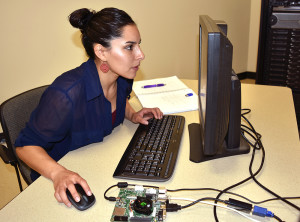
Photo: Margaret McKinney/Highlands University
Highlands University computer science student Rosie Vasquez uses the small imbedded super computer shown in the foreground to run her computational models for a nanomaterials research project at the university.
Las Vegas, N.M. – Highlands University computer science students are conducting cutting-edge nanomaterial light interaction research that has potential for advancing solar cell efficiency and cancer treatments.
The students are research assistants in computer science professor Gil Gallegos’ Computational Science Laboratory. The National Science Foundation is funding their paid internships.
“Nanoparticles are smaller than wavelengths of light, making them the perfect material to control the behavior of light at the atomic level,” Gallegos said. “My students are building and testing computational mathematical models of light-matter interaction that allows them to guide light and concentrate it on the surface of the nanomaterial.”
Gallegos said the novel research has the potential to be a game changer for the world of energy because it can result in producing more efficient solar cells for less. He said the research also shows promise for cancer treatments.
He said silver, gold and graphene were selected for the study because they interact well together, explaining that free electrons are loosely bound to metals and can move around.
“Our study is about plasmonics, which is the interaction between an electromagnetic field and free electrons in a metal,” said Rosie Vasquez, one of Gallegos’ undergraduate research assistants. “We are developing computational models to discover light interaction with three nanomaterials: gold, silver and graphene.”
Gallegos said it is a multidisciplinary study, with Highlands chemistry professor Jiao Chen contributing to the nanomaterials portion of the research. Ohio State University is another research partner.
Vasquez and the other computer science students, including graduate student Jared Leyba, are writing computer code and compiling it through a mathematical software program MIT designed to model electromagnetic systems.
“One of the most exciting potential applications for this research is for treating tumors in cancer patients. Our models can demonstrate the potential for using a focused laser beam to create a light interaction with gold nanoparticles in cancerous tissues to burn and destroy them without harming the surrounding healthy tissue,” said Vasquez, who will graduate in May with a B.S. in computer science and a minor in mathematics.
Gallegos, who has advised Vasquez since she was a freshman, said she is a valuable member of his research team. Vasquez is a 23-year-old from Coachella, California. She is the youngest of seven, the first in her family to attend college, and a first-generation Mexican-American.
“Rosie’s math background is exceptional, which makes her the perfect candidate for doing computational research like this because it requires both strong math and computer science knowledge,” Gallegos said. “She’s very tenacious and curious when solving challenging scientific problems. Rosie has the drive, intelligence and ability needed to pursue her computer science studies at the graduate level and excel.”
Vasquez honed her computer science knowledge in classes Gallegos taught such as artificial neural networks, machine architecture and assembly language, and parallel and distributed programming.
She is a math mentor in the university’s Achieving in Research, Math and Science program, ARMAS, assisting students with algebra, geometry, pre-calculus and calculus I-III.
“This research internship with Dr. Gallegos has been a wonderful opportunity,” Vasquez said “It’s been exciting, challenging and rewarding. He has high expectations for us, and pushes us to excel. He’s an incredible mentor who believes in my ability, which inspires me to do my best work,” Vasquez said.
The grant that funds Gallegos’ research is part of a five-year $3.3-million NSF Partnerships for Research and Education in Materials, or PREM, grant that Highlands chemistry professor Tatiana Timofeeva authored and leads.
Highlands President Sam Minner said the computer science students’ research project is a prime example of high-impact practices, or HIPs, which increase student achievement.
“This kind of collaborative research with a student working shoulder to shoulder with a professor in a lab is the kind of powerful learning that can be transformational,” Minner said. “Highlands already has a good reputation for promoting high-impact learning though research, meaningful service projects, internships and more. We want to build on this.”
The Highlands Foundation is conducting a campaign to raise $250,000 in private money by March 31, 2016, for increasing high-impact practices through faculty development. The New Mexico Higher Education Department will provide a 2:1 match if the foundation raises the $250,000, creating a permanent $750,000 endowment.
“Please consider making a gift to support this critical initiative. I assure you it will be put to good use increasing student success,” Minner said.
Tax deductible donations to the HU-HIPs campaign may be made online at www.nmhufoundation.org/hu-hips-make-a-difference Or mail your contribution for HU-HIPs to New Mexico Highlands Foundation, NMHU, Box 9000, Las Vegas, NM 87701.
